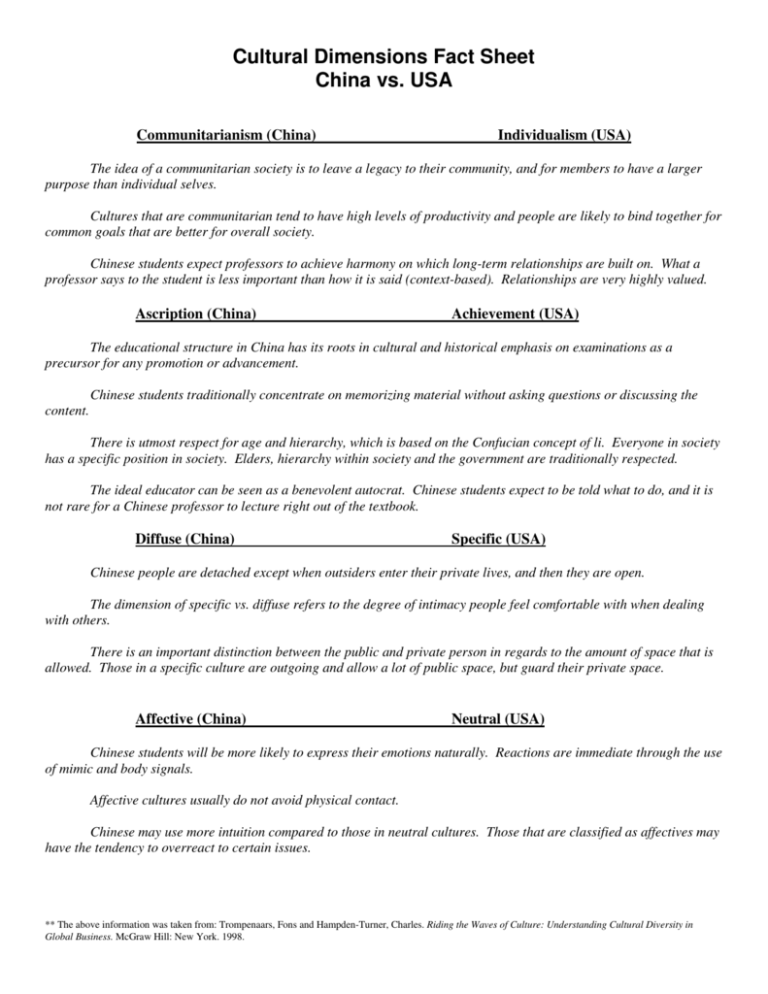Cultural Dimensions Fact Sheet China vs. USA
advertisement

Cultural Dimensions Fact Sheet China vs. USA Communitarianism (China) Individualism (USA) The idea of a communitarian society is to leave a legacy to their community, and for members to have a larger purpose than individual selves. Cultures that are communitarian tend to have high levels of productivity and people are likely to bind together for common goals that are better for overall society. Chinese students expect professors to achieve harmony on which long-term relationships are built on. What a professor says to the student is less important than how it is said (context-based). Relationships are very highly valued. Ascription (China) Achievement (USA) The educational structure in China has its roots in cultural and historical emphasis on examinations as a precursor for any promotion or advancement. Chinese students traditionally concentrate on memorizing material without asking questions or discussing the content. There is utmost respect for age and hierarchy, which is based on the Confucian concept of li. Everyone in society has a specific position in society. Elders, hierarchy within society and the government are traditionally respected. The ideal educator can be seen as a benevolent autocrat. Chinese students expect to be told what to do, and it is not rare for a Chinese professor to lecture right out of the textbook. Diffuse (China) Specific (USA) Chinese people are detached except when outsiders enter their private lives, and then they are open. The dimension of specific vs. diffuse refers to the degree of intimacy people feel comfortable with when dealing with others. There is an important distinction between the public and private person in regards to the amount of space that is allowed. Those in a specific culture are outgoing and allow a lot of public space, but guard their private space. Affective (China) Neutral (USA) Chinese students will be more likely to express their emotions naturally. Reactions are immediate through the use of mimic and body signals. Affective cultures usually do not avoid physical contact. Chinese may use more intuition compared to those in neutral cultures. Those that are classified as affectives may have the tendency to overreact to certain issues. ** The above information was taken from: Trompenaars, Fons and Hampden-Turner, Charles. Riding the Waves of Culture: Understanding Cultural Diversity in Global Business. McGraw Hill: New York. 1998. Eastern versus Western Educational System Fact Sheet Main Purpose USA - Focus on Individual - Develop individual’s full potential - Transmitter of cultural heritage Instruction Mode USA - Learner centered - Stresses understanding, application and ability - Use of educational psychology - Learner active Curricular Orientation USA - Present-future oriented - Development of whole person - Social interaction promoted East Asia - Focus on loyal citizenry - Develop literate citizenry - Transmitter of past cultural heritage - Helps select future leaders East Asia - Teacher centered - Stresses recall of facts - Use of rote learning - Examinations as motivator - Learner passive East Asia - Past-present oriented - Strict exams to develop academic knowledge - Concepts first then skills ** The above information was taken from: Chan, S. “The Chinese Learner – a question of style.” Education and Training. Vol. 41, 6/7, 1999. Tips for Preparing Lectures In order to maximize the potential of the Chinese student you should keep in mind the following: Group Discussion • Issues of status, saving face and shame may limit the openness of discussion, thus faculty should be aware of the hidden messages behind what is disclosed by students and be sensitive to such “constraints” on Chinese behavior. Use of case studies, role-play games, etc • Such approaches are heavily reliant on abstract thinking and could pose hazards for students not use to open discussions and opinion expressions. To be effective, such methods have to be introduced slowly with clear instructions and guidelines, as well as adequate preparation time. Student participation in classroom • To facilitate participation, it is important to allow the students the opportunity to define their roles at the outset, provide unambiguous instructions, as well as allow students more time to think about the topics under discussion. Long silences in the classroom may not simply be indications that students are refusing to participate, but that they may be thinking about the answers and require more probing and encouragement. The applicability of Western concepts to China • Care must be taken in producing supporting materials with Chinese examples instead of western ones. Also, care should be taken when translating English into Chinese as the mere translation may not have the same cultural reference as it does in America. ** The above information was taken from: Chan, S. “The Chinese Learner – a question of style.” Education and Training. Vol. 41, 6/7, 1999.





